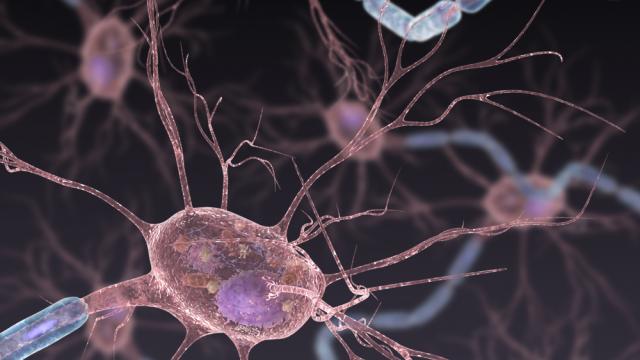Genetic engineering offers the promise of treating genetic disorders by correcting disease-causing DNA, but when the defective genes are located in cells deep inside the body, how do you actually deliver a cure?
Over the past year, the US Food and Drug Administration has approved therapies that work by genetically modifying a patient’s cells, but those therapies have all focused on cells that are easy to reach, like those in the blood. A new study in mice offers a glimpse at how researchers might use gene therapy on harder-to-reach cells — in this case, the motor neurons in the spinal cord responsible for amyotrophic lateral sclerosis, or Lou Gehrig’s disease.
ALS is a fatal neurodegenerative disease. Within three to five years of the first symptoms appearing, progressive weakening of the body’s muscles eventually leads to paralysis and death. There is no cure. The very best drugs on the market extend survival by only a few months.
Most cases of ALS disease are not inherited, but in a small percentage of cases, we know the exact gene responsible for causing its effects. A study published Wednesday in Science Advances from scientists at UC Berkeley focuses on one of those genes, SOD1. Dominant mutations to SOD1 are responsible for 20% of genetic ALS cases, and 2% of all ALS cases. SOD1 normally acts as an antioxidizing enzyme. In cases of SOD1 ALS, somehow it instead begins manufacturing a toxic protein. It’s not understood why.
The Berkeley researchers aimed to knock out the mutant SOD1 gene in mice with ALS using the gene-editing tool CRISPR/Cas9.
“I’ve been in gene therapy for 25 years, but only the advent of CRISPR has raised the possibility of erasing a gene,” study author David Schaffer told Gizmodo. “That’s where ALS comes in.”
The real test, though, was not only whether interfering with SOD1 would work as an effective treatment of the disease, but whether using what’s known as an adeno-associated virus could effectively penetrate the the spinal cord to deliver CRISPR into affected motor neurons with high enough efficiency. While it didn’t cure the disease, the treated mice lived about 25% longer and experienced disease onset significantly later. At the end of their lives, they also had about 50% more functional motor neurons.
“We really wanted to establish the proof of concept,” Schaffer said. “We have this whole joke in gene therapy that there are three main problems: delivery, delivery, and delivery.”
Most of Schaffer’s lab’s work focuses on modifying adeno-associated viruses to make them more effective delivery vehicles for gene therapy. The gene therapy for genetic blindness approved this week by the FDA relied on that type of modified virus. So has muscular dystrophy research and Huntington’s disease. In the current study, though, the virus was not able to target all of the affected cells. The next step, Schaffer said, is to pairing CRISPR with an engineered virus for highly efficient delivery in human cells (not mouse ones) to see whether it improves the efficacy of the treatment.
“Taken together with the recent, very promising initial gene therapy results for patients with Huntington’s Disease, we’re seeing some new therapeutic doors to some of the most serious nervous systems diseases,” Eric Topol, a geneticist at Scripps Research Institute not affiliated with the study, told Gizmodo.
But Topol cautioned that the research only applies to a very rare form of ALS. Additionally, he said, genome sequencing of the mice revealed a very small percentage of deleted SOD1 genes, making it hard to tell how effectively the therapy really worked.
Still, Topol said, it’s a step in the right direction.
“The results were nonetheless encouraging with many positive neurologic signs and delayed onset,” he said.
